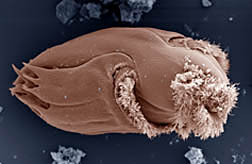This page has been archived and is being provided for reference purposes only. The page is no longer being updated, and therefore, links on the page may be invalid.
Read the magazine story to find out more. |
|
Cattle Protozoa Help Shift Antibiotic Resistance
By Luis PonsOctober 3, 2006
Agricultural Research Service (ARS) scientists in Ames, Iowa, have made another big finding about protozoa—single-celled predatory organisms—found in the gastrointestinal tract of cattle. They've discovered that the protozoa can facilitate the transfer of antibiotic resistance from resistant bacteria to susceptible types.
Veterinary medical officer Steven Carlson at ARS' National Animal Disease Center (NADC) in Ames is the first scientist to document the role rumen protozoa play in transferring this resistance within cattle. Rumen protozoa live in the first stomach (rumen) of cattle. They engulf and destroy most bacteria.
But Carlson and colleagues have identified and described the transfer of resistance to ceftriaxone, an antibiotic used to treat pneumonia, from gastrointestinal tract bacteria known as Klebsiella to rumen-dwelling Salmonella that are sensitive to the antibiotic.
Last year, Carlson teamed with microbiologist Mark Rasmussen—who's no longer with ARS—in a study that revealed for the first time that disease-causing bacteria can strengthen from interaction with protozoa that are naturally inside animals.
In that work, an antibiotic-resistant strain of Salmonella became especially virulent when tucked within rumen protozoa. That discovery suggests that naturally occurring digestive tract protozoa may be a place where dangerous bacteria can lurk and develop.
These studies exemplify how NADC is helping to make meals worry-free for people who enjoy meat and poultry. Its scientists continue to break new ground in protecting consumers against Salmonella,Escherichia coli,Campylobacter and other harmful foodborne bacteria.
Cutting-edge research there includes studies on how animal diets affect disease-causing pathogens and immunity, as well as molecular analyses of microbial virulence, antibiotic resistance and host response.
Read more about the latest work at the Ames center and other ARS research related to food safety in the October 2006 issue of Agricultural Research magazine.
ARS is the U.S. Department of Agriculture’s chief scientific research agency.

